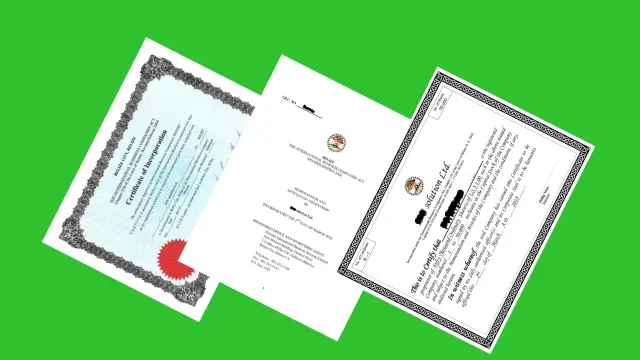As a corporate service providers, I am often asked about company documents, what they are and what their purposes are. In this article I will try to explain the most common corporate documents and why we use them. I will try to update them constantly so you can have the latest update.
- Certificate of incorporation (COI)
- Memorandum & articles of association (MAA)
- Register of directors (ROD)
- Register of shareholders & register of members (ROM)
- Share certificate
- Resolution
- Resolution of director
- Director letter of acceptance
- Certificate of incumbency
- Certificate of good standing (COGS)
- Register of beneficial owners
- Power of attorney (POA)
- Declaration of trust (DOT)
- Annual return declaration
- Minutes of directors
- Consent to act as secretary

Certificate of incorporation
Business owners who like to operate their company as a corporation must obtain a certificate of incorporation. A certificate of incorporation is a document that confirms the formation of your company. It is the main part of the basic documents of the company.
In English and Commonwealth legal systems, a founding certificate is usually a simple certificate issued by the relevant government registry.
Third parties, such as banks and new lenders or investors, request to see a copy of your certificate of incorporation. Therefore, this certificate applies to the following activities:
- Opening a corporate bank account
- Obtaining business licenses
- Hiring employees
- Tax registration
The information in this certificate varies from country to country, but may include:
- Company Name - The end of the company’s name must include "Corporation", "Incorporated", and “Company" as a suffix (or their abbreviation as "Inc.", "Corp." or "Co.").
- The official address of the company.
- Business code/Number.
- Type of corporation:
- Business stock.
- Business non-stock.
- Business-statutory close.
- Management.
- Professional.
- Insurance.
- Non-profit.
- Profit.
- Cooperative.
- Business purpose: the exact field of the company's activity.
- Number of shares allowed.
- Stock share value.
- Board of directors' names and addresses.
- Date of filing.
Given the importance of this certificate in business activities, consider the time required for its issuance so that you do not face any problems. The duration of the procedure may vary depending on the country. For Europeans, getting the certificate of incorporation may take three days, while for others it may take two months.
Some countries like, Belize, Seychelles or BVI, will give you the original document and others will give a copy that You may need to provide to investors, your board members or other parties.
Memorandum & Articles of Association:
A company is an incorporated entity, so some rules and regulations must be set up to manage its internal affairs and conduct business, as well as the relationship between members and the company. In addition, the rights and duties of its members and the company must be recorded. That is why the articles of association are necessary. The articles of association are a document that includes the purpose of the company as well as the duties and responsibilities of its members, which are clearly defined and recorded. This is an important document that must be registered in the company registration organization. Some countries divide this document into 2 parts:
1). Memorandum of Association:
The memorandum is the company's articles of association and forms the foundation on which its structure is based. This is the main document of the company and no company can be registered without a memorandum of association. Determines the scope of the company's activities as well as its relationship with the outside world. The memorandum includes:
- Company Name.
- Registry date.
- Company type.
- The law according to which the company is registered.
- Name and signature of all subscribers (major shareholders or guarantors).
- Limited liability of shareholders or guarantors.
The main purpose of this memorandum is to explain the scope of the company's activities. Potential shareholders are aware of the areas in which the company invests its money and the risk they put in investing money. Foreigners understand the limitations of the company's work and their dealings with it must remain within the specified range.
2). Articles of Association:
The rules and regulations for the internal management of the company are set out in a document called the articles of association. They determine the rights of shareholders, the rules governing the appointment, dismissal, and powers of company officers, the distribution of dividends, and the conduct of board meetings. These articles are designed to help the company achieve the goals set out in the Memorandum of association. This is a supplementary document to the Memorandum of association. Articles of Association include:
- Powers, responsibilities of managers, decision making, appointment, and dismissal, compensation and insurance.
- Shares, distribution of shares, and Dividends.
- Shareholders.
- General meetings.
- Voting right.
The term the articles of association of a company, or the articles of association of an American or Canadian company, are often simply referred to as articles. These articles are required by the law of India, the United Kingdom, Nigeria, Pakistan, and many other countries to establish a company.
The equivalent term LLC is the article of association of the organization. Almost equivalent terms exist in other countries, such as status in France, status in Poland, Jeong-Kwan in South Korea.
In South Africa, the association's articles and memorandum have been replaced by the "memorandum of incorporation" or "MOI" under the new Companies Act 2008, which began in 2011.
The managers and secretary of a company must have a good knowledge of the basic documents of the company, especially the articles of association.
It also makes sense for the board to review articles regularly. As the company and its terms change, some existing clauses may no longer be useful or new regulations may be desirable. By reviewing and, if necessary, updating the articles of association, the company can achieve the most appropriate balance between the needs of managers and members, and the former has the right authority to run the company while protecting the interests of its members.
Register of Directors (ROD)
Registration of directors is a list of directors that is generally stored in the company's minute’s book. In many jurisdictions, companies are required to keep a list of directors in the office of the companies in which the company is incorporated.
The first entries in the company’s register of directors should be made once the company has been successfully formed.
Companies are required to keep this list up to date to remove directors who have died or resigned, and to add people who have been elected. These records must specify the dates a director started and stopped holding office.
This certificate includes a number of details about each director appointed by the company to run its affairs. For each individual director, the following information must be entered in the management register:
- The individual’s full name.
- Date of birth.
- Nationality.
- Residence address (or, if necessary, registered office or head office).
- Business occupation.
- Date of Appointment: It is the date that they became the director of the company.
- Date of Cessation and Resignation: It is the date that they are no longer the director of the company
Register of shareholders & Register of members (ROM)
Members and shareholders are similar but distinct. Typically, the term “Member” refers to those whose name is somehow mentioned in the company's documents like directors, secretaries, and shareholders. Although it is different, this term refers to shareholders in many laws and countries.
In general, every shareholder is a member but every member, is not necessarily a shareholder.
In this article we explain the resister of shareholders document.
Register of shareholders:
Registration of shareholders is a list of all active and former shareholders of a company. It is essential for verifying the ownership of a company.
The directors of a company are obliged to constantly update the registration of shareholders and ensure that the current shareholders are registered in this list. Some shareholder registrations go so far as to assign all share issues in the past 10 years, along with the transfer date, to each shareholder.
For a company with a large number of shareholders, especially if the share is transferred frequently, a shareholder registration update may be more in demand. For example, the following changes need to be update:
- New shares are issued (whether to a new shareholder or an existing shareholder).
- The company's share is reorganized -for example, on a share split, share consolidation, share redemption, cancellation of shares, conversion of shares, etc.
- When shares are transferred from one person to another, whether by normal transfer of shares or transmission when a shareholder dies.
- A shareholder changes his name in marriage, by deed poll, and so on.
- A shareholder changes his address.
Let's see!
What information does shareholder registration include?
- Name of each shareholder.
- Contact address of each shareholder.
- Number and class (es) or type (s) of shares held by each shareholder.
- Amount paid or agreed to pay per share.
- The date that each shareholder became a member of the company.
- The date each shareholder ceased to be a member of the company (if applicable).
Some companies also choose to record other information, such as shareholder email addresses or dividend guidelines.
Share Certificate
A share certificate is a document that shows how much (how many percent) of shares, owned by someone in a company. This can be a paper or digital document issued to the shareholder and signed on behalf of the corporation. The information below mostly focuses on LLCs, LLPs, and ltd companies:
The share certificate is usually prepared and issued by the company secretary based on the details provided by the company and the shareholders. Three important details to consider:
- Serial number of the share certificate.
- Number of shares issued or transferred.
- Shareholder details.
It is important to know that a share certificate can be issued when:
- As per company bylaws, company directors are vested with the authority to issue new shares with the approval of shareholders.
- Articles of Association and the company Memorandum outline the processes to issue new shares or transfer their ownership.
This certificate must contain:
- Full company name.
- The registered address of the company's headquarters.
- Company registration number.
- Number of shares issued, numerically and in full word.
- Name of shareholder(owner of the shares).
- Class of shares.
- Issue date of shares.
Certificate of shares in public companies (PLCs) is known as a stock certificate too. In such companies:
Updating shareholder details is important to track any changes in stock ownership. Suppose an investor buys 50 shares of a company today. A month later he may sell 40 shares to another investor and a while later he buys another 50 shares from the same company. All details of this change of ownership must be pursued for audit purposes.
To protect the interests of shareholders, all companies must maintain a good track record of share certificates issued over the years.
Resolution
A board resolution, sometimes called a corporate resolution, is an official document that makes a statement about an issue. A resolution can be issued by the board of a company, shareholders on behalf of a company, a non-profit board, or a government agency.
While the board resolution is an important and legal document, it is a concise and simple resolution. Board approvals sometimes have a completely formal language and sometimes the language is quite straightforward. Board approvals must be written on the organization's letterhead. This phrase simply describes an operation that the board has agreed to perform. It also shows the date and names of the parties to the resolution.
The board can write an infinite number of important reasons for resolutions. In general, the board writes resolutions to formally document the information they have voted on and agreed upon to become part of the official record. There are common types of board approvals, and they can write a resolution for whatever reason the board deems appropriate. Resolutions can be written for the following reasons:
- The board needs to record what has been done in the board meeting for each purpose.
- The board of directors needs written documents related to the decision of the company's shareholders.
- The board wants to expand the company.
- The board and shareholders agree that the sale of additional shares of the company is appropriate.
- The board is making a fundamental decision that will have a significant impact on the company.
- The board has recognized that this is a good time to distribute corporate dividends.
- The board of directors has voted to dismiss or terminate another job of one or more directors.
Board approvals can also be written to document issues such as contract approval and budgeting.
How to write a resolution
- Format the resolution by placing the date and resolution number above. If this is the first board resolution, you can number it wherever you want.
- Make a title of the resolution that talks about the topic you want to document. For example, "2016 Budget Approval".
- Use the official language in the text of the resolution. The first sentence should refer to the responsibility of the board. For example, "whereas setting the budget for a specific purpose is the responsibility of the board."
- The final statement of the resolution must state the final resolution, an action taken by the Board. For example, "Now, the decision will be made on the 2016 budget."
- At the bottom of the resolution should be the names of the members of the board who voted for the resolution and the spaces adjacent to their names that may indicate a "yes" or "no" vote. Obviously, this resolution is adopted when a majority of the board members vote "yes".
- There should also be a place for the board to sign and a date for the resolution.
Keep resolutions with other important books and documents. They can also be kept with the minutes because they are legally binding documents.
Resolution of director
This resolution, which is also known as Board Resolution, Corporate Directors' Resolution, and Minutes of the Directors' Meeting is an official document that contains information about the meeting of the Board of Directors, the decisions taken in this meeting, and the necessary measures for implementing them.
Any corporate decisions that are made at the Directors' meeting can be documented in the board resolution, including, but not limited to:
- Election or dismissal of officers or managers.
- Change company policies or information.
- Financial decisions or approvals, such as approving loans or setting salaries for employees.
- Issuance of shares or approval of stock transfers.
- Hiring employees or contractors.
Directors' resolution is also referred to as consent to Action without Meeting. Provided that all directors agree and approve the resolution, it can be used instead of the company meeting to formally record the executive decisions of the board.
The board of directors is a group of people who oversee a corporation's important business decisions. The board is hired by the company's shareholders.
The directors' resolution generally includes a list of the names of all the directors of the company. It may also include the name of the chairperson of the meeting as well as the secretary. The other information is as follows:
- Company name.
- Registration Number.
- Date, time, and location.
- Subject description of the resolution.
- Signature of directors.
Director letter of acceptance
The Director Letter of Acceptance is written in response to an offer that has been made to someone to join a company as one of the directors. The tone of this letter should be formal and professional, and as the name implies, the acceptance letter has a positive response. It informs the reader of this decision and confirms the author's commitment. This letter is a way to complete a legal contract between the selected person and the company. It is the responsibility of the chosen person to verify that he or she understands the details of the offer. This letter can be used if the suggested elements are not clearly stated.What does this letter contain?
- Thanks and appreciation for this opportunity.
- Written acceptance of job offer.
- The terms of the contract, which may include rights, benefits, location, and more.
The following information is included in this letter:
- Sender Name (Selected Person).
- Company Name.
- Company address.
- Date.
- The text of the letter confirming the acceptance of this position by the person.
- Signature.
- Recipient name (reader of the letter).

Certificate of incumbency
A certificate of incumbency identifies who holds a position within the organization and is mostly used to verify the identities of those authorized by the company to conduct legal transactions. It is an official document issued by a corporation or limited liability company (LLC) that lists the names of current directors, officers, and some major shareholders.
In this document, the secretary or "company" confirms that the people named below hold the position within the company stated next to their names. The Secretary also certifies that the signature next to each person's name is their true signature and that they are authorized to take legal action on behalf of the company. This document also must contain the seal of the company to indicate that this is a company action and the document can be trusted for its accuracy.
When a company is opening an account or taking out a loan, a bank may apply for a certificate of incumbency. Similarly, a certificate can be applied for by a financial institution, a lawyer, or anyone else who wants to confirm the declared position of manager or member in a company. In general, the Incumbency Certificate is required when:
- A business is incorporating and must identify its officers.
- Someone in the company becomes a new officer and needs official documents.
- Someone becomes an administrative manager or secretary who is responsible for company documents.
- The qualifications of a particular officer must be confirmed in writing.
- Opening a foreign bank account.
- For tax purposes.
What information can be shown on the certificate of incumbency? By default, this document verifies the company name, registration number, membership date, and a statement to confirm a company. In addition, it contains additional information such as:
- Current and previous company names (if previous company name),
- Registration number,
- Information about the identity of managers and officers of the company.
- Name, position, selection or appointment, and duration of his / her responsibility.
- A sample signature for comparison.
- Date of birth of managers (month and year only).
- Registered office.
- Secretary's signature.
- Company seal.
Certificate of good standing (COGS)
A certificate of good standing is a document that shows the company is active and in good standing.
It is also known as a Certificate of Existence, Certificate of Authority or Certificate of Status. A certificate of good standing proves that a business in a country is legally registered and capable of operating in it.
Reasons why your company may need a good standing certification:
- It is necessary to provide a certificate of good standing to open an account in offshore banks if your company is registered more than one year ago.
- When you have a long-term contract with another company, you may need to provide a certificate of good standing to prove that your company is still active.
- Investors or business partners who want to make sure your business is legal and compliant with the rules and regulations.
- Business intermediaries or buyers - if you want to sell your business and you need to prove its existence, history and conformity.
It is not like an occupational license that must be obtained in order to legally conduct business. A company can trade legally without obtaining a certificate of good standing. You normally provide COGS to third parties upon their request.
This document contains the following information:
- Company name.
- Registration number.
- A short paragraph stating that the entity is allowed to trade in the jurisdiction.
- Date.
- Signature and Seal.
Register of beneficial owners
Register of Beneficial Owners is a document that lists the ultimate owners of the company.
Beneficiary ownership is a natural person who ultimately owns a legal entity (such as a company or foundation) through direct or indirect ownership.
Registers of beneficial ownership create transparency and play an important role in the fight against corruption, tax evasion, and money laundering.
This certificate includes the following information:
- Company name.
- Registration number.
- Full name.
- Nationality.
- Date of birth.
- National identity number.
- Business occupation.
- Passport number.
- Residential address.
- The date that a person became a beneficial owner.
- Date the person ceased to be a beneficial owner.
- Signature & Seal of company registery and directors.
Companies are also required to:
- Update registration in case of any new information from beneficial owners.
- Update company registration if any restrictions are imposed on beneficial owners.
Power of attorney (POA)
A power of attorney (POA) is a legal document that gives the power to act on another's behalf. the one who gives the power is normally called the principal and the one who receives the power is called the attorney. Power of attorney is an effective tool and has different types. A principal can allow their attorney to make any decisions (using a General power of attorney) or to make some of their decisions (using a limited power of attorney).
In offshore business, this is a legal letter that the nominee directors give to beneficiary owners. This letter allows them to officially manage their business and act on behalf of the directors.
The following information is included in a POA (used in offshore company):
- Type of POA.
- Complete information of the principal (beneficiary owner).
- Complete information of the attorney (nominee director).
- Complete information of company.
- Describe the specific powers.
- witness (full name, and signature).
- Date & location of writing
- Principal and agent signature
Declaration of trust (DOT)
A declaration of trust, also known as a Deed of Trust, is a legal document that appoints a position to oversee assets held for the benefit of one or more persons. This document provides details such as the purpose of the trust, its beneficiaries, and how it is managed by the trustee.
A trustee is a person or company who can maintain and manage assets on behalf of a beneficiary under the terms of a trust agreement. Common trustees include banks, trusted companies or individuals.
In offshore businesses, DOT is a document that proves the nominee shareholders appoint the beneficiary owners to oversees the assets and shares. It is a document that returns all the rights of company shares and assets to the beneficiary owners.
Declaration of trust should contain the following information:
- Full name.
- Identity number.
- Company name.
- Registration number
- Usually requires people as witness
- Date
- Signature & Seal
Annual return declaration
The annual return declaration is a document that declares the date and location on which the company's financial statements are compiled.
It shows where the accounting records, director resolutions, and minutes of meetings are kept.
Companies have to file and update this document each year with the following information:
- Complete information of company like name, registration number, and address.
- Registered office address.
- Company registery (licensses agent) information.
- Main business activity.
- Location of accounting records.
- Location of directr resolutions.
- Fiscal year.
- Date of declaration.
- Director/authorized signature.
In some countries they required you put director, shareholders, and secretaries information as well.
Minutes of directors
Board meeting minutes are a legal record of the actions and decisions of the directors. The board of directors meets throughout the year to review various issues, such as the association's progress in following its strategic guidelines, reviewing and revising guidelines. Meeting Minutes usually include the chairman's report, the business and financial agenda, and discussions of new topics covered by the board. Taking good meeting minutes is an important and fulfilling role.
Board minutes go beyond a general accounting of board discussions. Minutes are used in a variety of ways, including tracking progress, details of plans, and usage as a reference point.
The following information is recorded:
- Date of the meeting.
- Meeting time and place.
- Names of participants and absentees.
- The person who records the minutes.
- Result of votes (in case of voting).
- A brief description of the issues and actions taken.
- Use simple language to convey information.
Consent to act as secretary
Consent to act as secretary is the written consent that must be given by any person who is to act as secretary of a company. Given the significant responsibilities of the company secretary, they must understand the legal duties associated with this role and provide written records of their consent to do so.
Some of a secretary's responsibilities include:
- Maintain company records.
- Arrange meetings for members and meeting schedules.
- Take minutes of member meetings.
- Make sure the company's legal obligations are met.
This document contains:
- Company name.
- Registration number.
- Date .
- Describe the exact responsibilities.
- Full name.
- Date of birth.
- Nationality.
- Passport number.
- Signature.


